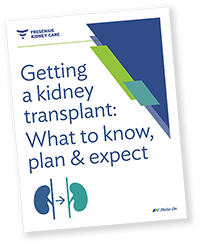The Kidney Transplant Waitlist
For many of the millions of people living with kidney failure, a kidney transplant is considered the most ideal and desirable treatment option. However, transplantation is a process that can take months or even years due to the number of people in need of a new kidney.
If you don’t have a living kidney donor or if your donor arrangements aren’t finalized, registering on the national kidney transplant waiting list for a donor kidney is an important step. Once you’ve registered–with help from your social worker and a referral–you’ll be on the list to receive a kidney from a donor when a match becomes available.
The National Kidney Transplant Waiting List: 6 Common Questions
1. When am I eligible to be on the waitlist?
2. How do I get evaluated and placed on the waitlist?
The next step is to find an area transplant hospital. The Organ Procurement and Transplantation Network (OPTN) has a list of 200+ such hospitals in the United States. You should look for a facility that will work with/for your insurance, travel, financial, and support needs.
The final step is an evaluation by the hospital's transplant team. This typically starts with a phone conversation, during which you’ll set up an in-person appointment with members of the transplant care team. You will also undergo a full health exam. If your exam shows you’re a transplant candidate—meaning you are physically and mentally prepared for the transplant process—you’ll be added to the national waitlist. The sooner you can get on the list, the sooner you may find a matching donor.
3. How long will I be on the waitlist?
Once you register to be on the kidney transplant waitlist, there may be a fairly long wait. There are approximately 100,000 people on the waitlist1 and the average wait time for a kidney from a deceased donor is three to five years.2
4. Can I do anything to get a kidney sooner?
5. How will I know my transplant list status?
6. How do I stay healthy while on the waitlist?
Staying healthy means you'll be more physically, medically, and mentally prepared when a kidney becomes available. Tips for staying your healthiest include:
- Attend medical appointments and evaluations.
- Keep up with dialysis therapy, medications, and vaccinations.
- Eat healthy, exercise, and cut out bad habits like smoking.
- Seek out the emotional and mental support you need.
1: Kidney Disease: The Basics, kidney.org, April 2021, https://www.kidneyfund.org/kidney-donation-and-transplant/transplant-waiting-list
2: The Kidney Transplant Waitlist – What You Need to Know, kidney.org, February 2017, https://www.kidney.org/atoz/content/transplant-waitlist
Suggested topics

“She just called me one day and said ‘Dad, I’m a match.’”
What You Should Know as You Prepare for a Kidney Transplant
Right now, tens of thousands of people with kidney disease are considering or planning for a kidney transplant. If this is an option you’re starting to explore, you probably have lots...

Finding a Kidney Donor
Once your doctor has determined that you’re a good candidate for a kidney transplant, you’ll need to be matched with a kidney donor who is compatible with you in tissue and blood type...

